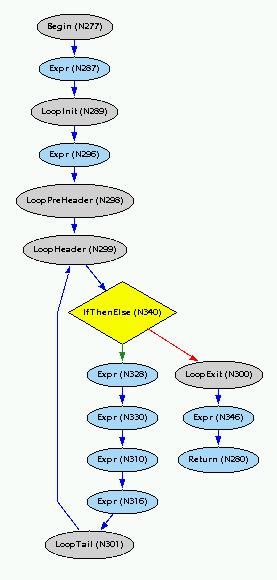 scale.common.Root
scale.common.Root
 scale.score.Note
scale.score.Note
 scale.score.chords.Chord
scale.score.chords.Chord
 scale.score.chords.SequentialChord
scale.score.chords.SequentialChord
 scale.score.chords.LoopPreHeaderChord
scale.score.chords.LoopPreHeaderChord
|
|||||||||
| PREV CLASS NEXT CLASS | FRAMES NO FRAMES | ||||||||
| SUMMARY: NESTED | FIELD | CONSTR | METHOD | DETAIL: FIELD | CONSTR | METHOD | ||||||||
java.lang.Objectscale.common.Root
scale.score.Note
scale.score.chords.Chord
scale.score.chords.SequentialChord
scale.score.chords.LoopPreHeaderChord
public class LoopPreHeaderChord
This class represents the start of a loop but is not part of the loop.
$Id: LoopPreHeaderChord.java,v 1.30 2006-02-28 16:37:08 burrill Exp $
Copyright 2005 by the Scale Compiler Group,
Department of Computer Science
University of Massachusetts,
Amherst MA. 01003, USA
All Rights Reserved.
No code is generated for this node.
The out-going CFG edge always points to a LoopHeaderChord.
We need to mark the end of a loop so that there are only two in-coming CFG edges
to a LoopHeaderChord instance.
Don't assume that a LoopPreHeaderChord instance will always end a basic block. For example, a
do { } while (false);
will not have a LoopTailChord after SCC.

LoopHeaderChord,
LoopTailChord,
LoopExitChord,
LoopInitChord| Field Summary |
|---|
| Fields inherited from class scale.score.chords.Chord |
|---|
lineNumber |
| Constructor Summary | |
|---|---|
LoopPreHeaderChord()
|
|
LoopPreHeaderChord(Chord next)
|
|
| Method Summary | |
|---|---|
Chord |
copy()
Make a copy of this CFG node with the same out-going CFG edges. |
DColor |
getDisplayColorHint()
Return a String specifying the color to use for coloring this node in a graphical display. |
boolean |
isLoopPreHeader()
Return true if this chord is a LoopPreHeaderChord. |
boolean |
isSpecial()
Return true if this is chord was added for the convenience of the compiler and does not correspond to actual source code in the user program. |
void |
visit(Predicate p)
Process a node by calling its associated routine. |
| Methods inherited from class scale.score.Note |
|---|
getChord, getEssentialUse, setAnnotationLevel, setReportLevel, toString, validate |
| Methods inherited from class scale.common.Root |
|---|
addAnnotation, allAnnotations, allMatchingAnnotations, getAnnotation, getDisplayName, getDisplayString, getNodeCount, getNodeID, hasAnnotation, hasEqualAnnotation, hashCode, removeAnnotation, removeAnnotations, toStringAnnotations, toStringClass, trace, trace, trace |
| Methods inherited from class java.lang.Object |
|---|
clone, equals, finalize, getClass, notify, notifyAll, wait, wait, wait |
| Constructor Detail |
|---|
public LoopPreHeaderChord(Chord next)
public LoopPreHeaderChord()
| Method Detail |
|---|
public Chord copy()
Chord
copy in class Chordpublic boolean isSpecial()
isSpecial in class Chordpublic final boolean isLoopPreHeader()
isLoopPreHeader in class Chordpublic void visit(Predicate p)
Note
Each class has a visit(Predicate p) method. For
example, in class ABC:
public void visit(Predicate p)
{
p.visitABC(this);
}
and the class that implements Predicate has a method
public void visitABC(Note n)
{
ABC a = (ABC) n;
...
}
Thus, the class that implements Predicate can call
n.visit(this);where
n is a Note sub-class without
determining which specific sub-class n is.
The visit pattern basically avoids implementing a large
switch statement or defining different methods
in each class for some purpose.
visit in class NotePredicatepublic DColor getDisplayColorHint()
getDisplayColorHint in interface DisplayNodegetDisplayColorHint in class ChordDColor
|
|||||||||
| PREV CLASS NEXT CLASS | FRAMES NO FRAMES | ||||||||
| SUMMARY: NESTED | FIELD | CONSTR | METHOD | DETAIL: FIELD | CONSTR | METHOD | ||||||||